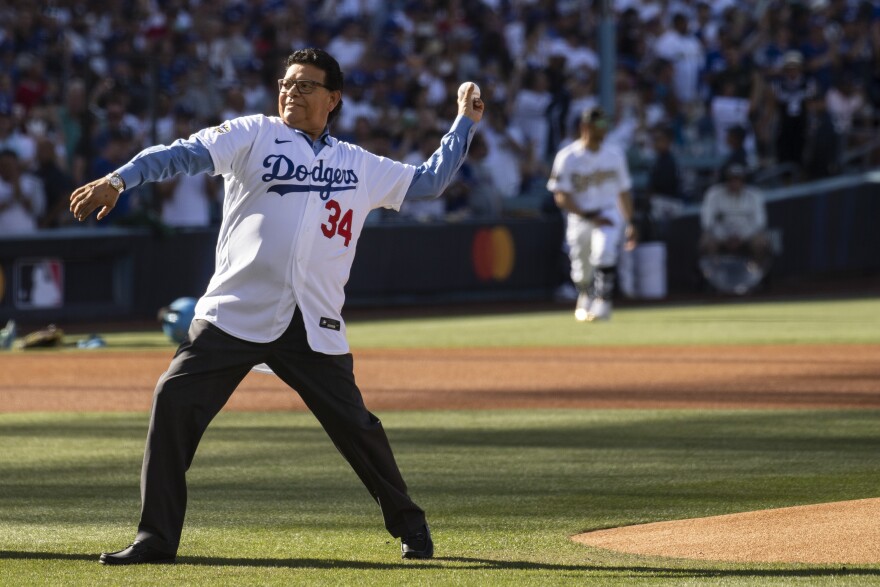This story is free to read because readers choose to support LAist. If you find value in independent local reporting, make a donation to power our newsroom today.
Viva El Toro! The Dodgers Retire Fernando Valenzuela's No. 34

Fernando Valenzuela's number 34 jersey was retired by the Dodgers last night in front of a packed stadium crowd before the team took on the Colorado Rockies.
Fernando for ever. ⚾️ 💪🏽❤️
— 8/24Mambalytics (@el_jefe562) August 12, 2023
🇲🇽 ✊🏽#fernandomania pic.twitter.com/rHYL8D1dub
The Dodgers pulled out all the stop to fete the legendary southpaw with the vicious screwball who's been dubbed "El Toro."
As part of the celebration, Valenzuela threw out the first pitch to his old catcher Mike Scioscia.
The party continues this weekend: a bobblehead of the pitcher will be given out at tonight's game against the Rockies, while a ticket to Sunday's game will get you a Valenzuela replica 1981 World Series ring.
Fernando Valenzuela threw the 1st pitch! ⚾️💙 #FernandoValenzuela #ElToro #FernandoMania #1stpitch #GoDodgers #LADodgers #Dodgers #LosAngeles #LA pic.twitter.com/pm6AaGYABX
— LA Born & Raised (@LABornRaised13) August 12, 2023
LAist.com's Josie Huang revisits the legends of Dodgers' No. 34 with Erik Sherman, a baseball historian and author of the book, "Daybreak at Chavez Ravine: Fernandomania and the Remaking of the Los Angeles Dodgers."
Q: Fernando Valenzuela is credited with building this huge Latino fan base for the Dodgers. Talk about how Mexican Americans saw the Dodgers before Valenzuela became this legendary left-hander?
Sherman: "Fernandomania" in 1981 hit the city like a thunderbolt. He came out with one of the greatest starts to a baseball career for a starting pitcher in the history of the game. But the legend of Fernando Valenzuela really didn't start there. It began way, way back in the early '50s.
Great @Dodgers drone show tonight honoring Fernando Valenzuela! #VivaFernando #FernandoValenzuela #Fernandomania #LADodgers #Dodgers 😍⚾️💙 pic.twitter.com/IFLYewL2BZ
— LA Born & Raised (@LABornRaised13) August 12, 2023
Through eminent domain, Mexican Americans were being forced to sell their homes and to make room for affordable housing. Then the Red Scare came and basically nixed that plan. The city was left with 300 acres of land. The Dodgers come in from Brooklyn, and the last remaining residents — all Mexican Americans — and two and three generations were forced to leave, and the last remaining ones were literally dragged out and watch their homes get bulldozed.
There was a lot of ill will between Mexican Americans and Latinos and the Dodgers for 20 years until Fernando came along and absolutely changed the dynamic of that, and brought Latinos into Dodger Stadium for the first time in large numbers.
34 forever. pic.twitter.com/laV025wdIu
— Los Angeles Dodgers (@Dodgers) August 12, 2023
Q: Fernando made a name for himself in 1981 — that's 20 years or so after these Latino homeowners were forced out of their homes. And you have this Mexican-born pitcher on the opening day of the 1981 Dodgers season when he was called up to the mound to go up against the Houston Astros.
Sherman: It was incredible. He actually pitched in long relief for 17 shutout innings at the end of the 1980 season, but he was still kind of in the baseball witness protection program until opening day of '81, when the top two Dodgers starting pitchers were injured, and the other two had just pitched exhibition games against the Angels.
A perfect way to end the night.
— Los Angeles Dodgers (@Dodgers) August 12, 2023
Day 1 of Fernandomania Weekend presented by @Yaamava is in the books! pic.twitter.com/Mri0OrMBaR
So this 20-years-old kid who had never started a game in the major leagues is thrust out on Opening Day to pitch against the defending division winners, the Houston Astros. And he goes out and pitches a shutout. Just remarkable. "Fernandomania" was born that day and lived on for the next 10 seasons in Los Angeles.
New retired number 👀 pic.twitter.com/uZq5L29B0s
— DodgersBeat (@DodgersBeat) August 11, 2023
Q: So Valenzuela notched some milestones like winning the National League Rookie of the Year in 1981, he also won the Cy Young Award, but you write about how his appeal went just beyond the talent. What was it about him and his life story that made him so popular and also so relatable?
Sherman: Well, that's a great word: Relatable. So he was bringing out Mexican, Mexican Americans in droves. Prior to Fernando, about 5% of the crowds at Dodger Stadium were Latino. On days he pitched that percentage shot up to 50%. He was so relatable because, you know, he was not a physical specimen. He was kind of pudgy, had kind of a funny haircut and didn't look athletic looking.
And he kind of reminded so many Mexicans and Latinos that I spoke to of their older brother or their uncle, and if he could be the very, very best of his craft, then they could be the best at their crafts.









